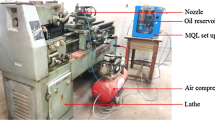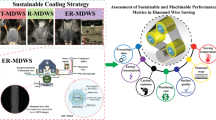Abstract
Sustainable manufacturing is essential to minimize energy consumption and environmental footprints. In the diamond wire sawing (DWS) process, minimizing energy consumption without compensating for the surface roughness of as-sawn wafer is crucial for achieving a cost-effective and environmentally friendly process. However, the evaluation and assessment of energy consumption without compromising the surface roughness of the as-sawn wafer in the DWS process have not been thoroughly studied. This study aims to investigate the correlation between energy consumption (EC), surface roughness (Ra), and material removal rate (MRR) of DWS to effectively reduce environmental footprints and simultaneously improve the surface quality of the as-sawn wafer during a single-wire DWS process. Experiments have been conducted on monocrystalline silicon (Si), incorporating various process parameters, namely wire speed, feed rate, and wire tension, as controllable factors. A mathematical relationship between the parameters has been formulated using the response surface methodology and optimized using a multi-objective particle swarm optimization (MOPSO). Results show that the optimum parameter combination is obtained at a wire speed of 0.36 m/s, a feed rate of 0.029 mm/min, and wire tension of 7 N and has reduced energy consumption, surface roughness, and MRR of 8.53%, 2.85%, and 4.86%, respectively, when compared to the traditional sawing process based on per wafer. Results of this study can be applied on the multi-wire DWS of Si wafer processing for achieving sustainable manufacturing practices.
Graphical Abstract












Similar content being viewed by others

References
Khan AM, Jamil M, Salonitis K et al (2019) Multi-objective optimization of energy consumption and surface quality in nanofluid SQCL assisted face milling. Energies 12(4):710. https://doi.org/10.3390/en12040710
Schneider F, Das J, Kirsch B et al (2019) Sustainability in ultra precision and micro machining: a review. Int J Precis Eng Manuf-Green Technol 6(3):601–610. https://doi.org/10.1007/s40684-019-00035-2
Bourhis FL, Kerbrat O, Hascoet J-Y et al (2013) Sustainable manufacturing: evaluation and modeling of environmental impacts in additive manufacturing. Int J Adv Manuf Technol 69(9):1927–1939. https://doi.org/10.1007/s00170-013-5151-2
Kaya S, Aydin G, Karakurt I (2023) An experimental study on the cutting depth produced by abrasive waterjet: how do abrasive and rock properties affect the cutting process? Int J Adv Manuf Technol 125(9):4811–4823. https://doi.org/10.1007/s00170-023-11053-5
Aydin G, Karakurt I, Amiri MR et al (2022) Improvement of rock cutting performance through two-pass abrasive waterjet cutting. Sustainability 14(19):12704. https://doi.org/10.3390/su141912704
Celep O, Aydin G, Karakurt I (2013) Diamond recovery from waste sawblades: a preliminary investigation. Proc Inst Mech Eng, Part B: J Eng Manuf 227(6):917–921. https://doi.org/10.1177/0954405412471524
Freitas Gomes IS, Perez Y, Suomalainen E (2020) Coupling small batteries and PV generation: a review. Renew Sustain Energy Rev 126:109835. https://doi.org/10.1016/j.rser.2020.109835
Sahu A, Garg A, Dixit A (2020) A review on quantum dot sensitized solar cells: past, present and future towards carrier multiplication with a possibility for higher efficiency. Solar Energy 203:210–239. https://doi.org/10.1016/j.solener.2020.04.044
Wu X, Tan Y, Li J et al (2020) Surface damage and metal-catalyzed chemical etching investigation of multicrystalline silicon by diamond wire sawing. Solar Energy 207:609–617. https://doi.org/10.1016/j.solener.2020.07.019
Kumar A, Melkote SN (2018) Diamond wire sawing of solar silicon wafers: a sustainable manufacturing alternative to loose abrasive slurry sawing. Procedia Manuf 21:549–566. https://doi.org/10.1016/j.promfg.2018.02.156
Sen B, Mia M, Krolczyk GM et al (2021) Eco-friendly cutting fluids in minimum quantity lubrication assisted machining: a review on the perception of sustainable manufacturing. Int J Precis Eng Manuf-Green Technol 8(1):249–280. https://doi.org/10.1007/s40684-019-00158-6
Benedicto E, Rubio EM, Aubouy L et al (2022) Sustainable lubrication/cooling systems for efficient turning operations of γ-TiAl parts from the aeronautic industry. Int J Precis Eng Manuf-Green Technol. https://doi.org/10.1007/s40684-022-00435-x
Triebe MJ, Zhao F, Sutherland JW (2022) Modelling the effect of slide table mass on machine tool energy consumption: the role of lightweighting. J Manuf Syst 62:668–680. https://doi.org/10.1016/j.jmsy.2022.02.003
Selvaraj V, Xu Z, Min S (2022) Intelligent operation monitoring of an ultra-precision CNC machine tool using energy data. Int J Precis Eng Manuf-Green Technol. https://doi.org/10.1007/s40684-022-00449-5
Chiang CY, Kocabasoglu-Hillmer C, Suresh N (2012) An empirical investigation of the impact of strategic sourcing and flexibility on firm’s supply chain agility. Int J Oper Prod Manag 32(1):49–78. https://doi.org/10.1108/01443571211195736
Abdul-Rashid SH, Mohamad MN, Sakundarini N et al (2022) Modelling sustainable manufacturing practices effects on sustainable performance: the contingent role of ownership. Int J Adv Manuf Techno 122(9):3997–4012. https://doi.org/10.1007/s00170-022-10140-3
Newman ST, Nassehi A, Imani-Asrai R et al (2012) Energy efficient process planning for CNC machining. CIRP J Manuf Sci Technol 5(2):127–136. https://doi.org/10.1016/j.cirpj.2012.03.007
Mymrin V, Praxedes PB, Alekseev K et al (2019) Manufacturing of sustainable ceramics with improved mechanical properties from hazardous car paint waste to prevent environment pollution. Int J Adv Manuf Technol 105(5):2357–2367. https://doi.org/10.1007/s00170-019-04302-z
Pei ZJ (2002) A study on surface grinding of 300 mm silicon wafers. Int J Mach Tools Manuf 42(3):385–393. https://doi.org/10.1016/S0890-6955(01)00122-5
Möller HJ (2004) Basic mechanisms and models of multi-wire sawing. Adv Eng Mater 6(7):501–513. https://doi.org/10.1002/adem.200400578
Tsai Y-Y, Ho J-K, Wang W-H et al (2020) Grey-Taguchi-based optimization of wire-sawing for a slicing ceramic. Processes 8(12):1602. https://doi.org/10.3390/pr8121602
Li X, Gao Y, Yin Y et al (2020) Experiment and theoretical prediction for surface roughness of PV polycrystalline silicon wafer in electroplated diamond wire sawing. J Manuf Process 49:82–93. https://doi.org/10.1016/j.jmapro.2019.11.022
Costa EC, Weingaertner WL, Xavier FA (2022) Influence of single diamond wire sawing of photovoltaic monocrystalline silicon on the feed force, surface roughness and micro-crack depth. Mater Sci Semicond Process 143:106525. https://doi.org/10.1016/j.mssp.2022.106525
Gupta A, Chen C-CA, Hsu H-W (2019) Study on diamond wire wear, surface quality, and subsurface damage during multi-wire slicing of c-plane sapphire wafer. Int J Adv Manuf Technol 100(5):1801–1814. https://doi.org/10.1007/s00170-018-2656-8
Yin Y, Gao Y, Wang L et al (2021) Analysis of crack-free surface generation of photovoltaic polysilicon wafer cut by diamond wire saw. Solar Energy 216:245–258. https://doi.org/10.1016/j.solener.2021.01.009
Kumar A, Kaminski S, Melkote SN et al (2016) Effect of wear of diamond wire on surface morphology, roughness and subsurface damage of silicon wafers. Wear 364–365:163–168. https://doi.org/10.1016/j.wear.2016.07.009
Würzner S, Falke A, Buchwald R et al (2015) Determination of the impact of the wire velocity on the surface damage of diamond wire sawn silicon wafers. Energy Procedia 77:881–890. https://doi.org/10.1016/j.egypro.2015.07.124
Gao YF, Ge PQ (2010) Experimental investigation on Brittle-ductile transition in electroplated diamond wire saw machining single crystal silicon, in Key Engineering Materials: Trans Tech Publ, 431, pp. 265–268. https://doi.org/10.4028/www.scientific.net/KEM.431-432.265
Hardin CW, Qu J, Shih AJ (2004) Fixed abrasive diamond wire saw slicing of single-crystal silicon carbide wafers. Mater Manuf Process 19(2):355–367. https://doi.org/10.1081/AMP-120029960
Wang L, Gao Y, Li X et al (2020) Analytical prediction of subsurface microcrack damage depth in diamond wire sawing silicon crystal. Mater Sci Semicond Process 112:105015. https://doi.org/10.1016/j.mssp.2020.105015
Costa EC, Xavier FA, Knoblauch R et al (2020) Effect of cutting parameters on surface integrity of monocrystalline silicon sawn with an endless diamond wire saw. Solar Energy 207:640–650. https://doi.org/10.1016/j.solener.2020.07.018
Chen CCA, Cheng SC, Chan MH et al (2014) Design and test of a rapid thermal annealing furnace for improving surface properties of silicon brick in multi-wire sawing process. Adv Mater Res 939:437–442. https://doi.org/10.4028/www.scientific.net/AMR.939.437
Suzuki T, Nishino Y, Yan J (2017) Mechanisms of material removal and subsurface damage in fixed-abrasive diamond wire slicing of single-crystalline silicon. Precis Eng 50:32–43. https://doi.org/10.1016/j.precisioneng.2017.04.011
Wang Y, Zhao B, Huang S et al (2021) Study on the subsurface damage depth of monocrystalline silicon in ultrasonic vibration assisted diamond wire sawing. Eng Fract Mech 258:108077. https://doi.org/10.1016/j.engfracmech.2021.108077
Kovalchenko A, Pashchenko E, Savchenko D (2021) Research on suppressing brittle fracture and implementing ductile mode cutting for improving surface quality at silicon wafers manufacturing. J Phys: Conference Series 2045(1):012005. https://doi.org/10.1088/1742-6596/2045/1/012005. (IOP Publishing)
Xiao H, Wang H, Yu N et al (2019) Evaluation of fixed abrasive diamond wire sawing induced subsurface damage of solar silicon wafers. J Mater Process Technol 273:116267. https://doi.org/10.1016/j.jmatprotec.2019.116267
Xu Z, Feng Y, Pan L et al (2020) Influence of ingot rocking on the surface quality of multi-wire sawing monocrystalline silicon wafers. Int J Adv Manuf Technol 107(1):15–24. https://doi.org/10.1007/s00170-020-04996-6
Gao Y, Ge P, Zhang L et al (2019) Material removal and surface generation mechanisms in diamond wire sawing of silicon crystal. Mater Sci Semicond Process 103:104642. https://doi.org/10.1016/j.mssp.2019.104642
Güney T (2021) Renewable energy consumption and sustainable development in high-income countries. Int J Sustain Dev World Ecol 28(4):376–385. https://doi.org/10.1080/13504509.2020.1839807
Rödger J-M, Beier J, Schönemann M et al (2021) Combining life cycle assessment and manufacturing system simulation: evaluating dynamic impacts from renewable energy supply on product-specific environmental footprints. Int J Precis Eng Manuf -Green Technol 8(3):1007–1026. https://doi.org/10.1007/s40684-020-00229-z
Chen CCA, Chao PH (2010) Surface texture analysis of fixed and free abrasive machining of silicon substrates for solar cells. Adv Mater Res 126:177–180. https://doi.org/10.4028/www.scientific.net/AMR.126-128.177. (Trans Tech Publ)
Li L, Ren X, Feng H et al (2021) A novel material removal rate model based on single grain force for robotic belt grinding. J Manuf Process 68:1–12. https://doi.org/10.1016/j.jmapro.2021.05.029
Klocke F, Kuchle A (2009) Manufacturing processes (vol 2, pp. p–433). Berlin: Springer
Malkin S, Guo C (2008) Grinding technology: theory and application of machining with abrasives. Industrial Press Inc
Khoshaim AB, Xu Z, Marinescu ID (2015) Chapter 9 - ELID Grinding with Lapping Kinematics. In: Marinescu ID, Doi TK, Uhlmann E (eds) Handbook of Ceramics Grinding and Polishing. William Andrew Publishing, Boston, pp 394–448
Hanafi I, Cabrera FM, Dimane F et al (2016) Application of particle swarm optimization for optimizing the process parameters in turning of PEEK CF30 composites. Procedia Technol 22:195–202. https://doi.org/10.1016/j.protcy.2016.01.044
Malghan RL, Rao KMC, Shettigar AK et al (2017) Application of particle swarm optimization and response surface methodology for machining parameters optimization of aluminium matrix composites in milling operation. J Braz Soc Mech Sci Eng 39(9):3541–3553. https://doi.org/10.1007/s40430-016-0675-7
Rushing H, Karl A, Wisnowski J (2014) Design and analysis of experiments by Douglas Montgomery: a supplement for using JMP. SAS Institute Inc., Cary, North Carolina, USA
Han F, Li L, Cai W et al (2020) Parameters optimization considering the trade-off between cutting power and MRR based on linear decreasing particle swarm algorithm in milling. J Clean Prod 262:121388. https://doi.org/10.1016/j.jclepro.2020.121388
Dileep G, Singh SN (2017) An improved particle swarm optimization based maximum power point tracking algorithm for PV system operating under partial shading conditions. Solar Energy 158:1006–1015. https://doi.org/10.1016/j.solener.2017.10.027
Khare A, Rangnekar S (2013) A review of particle swarm optimization and its applications in solar photovoltaic system. Appl Soft Comput 13(5):2997–3006. https://doi.org/10.1016/j.asoc.2012.11.033
Mirjalili S, Lewis A (2013) S-shaped versus V-shaped transfer functions for binary particle swarm optimization. Swarm Evol Comput 9:1–14. https://doi.org/10.1016/j.swevo.2012.09.002
Zhan Z-H, Zhang J, Li Y et al (2010) Orthogonal learning particle swarm optimization. IEEE Trans Evol Comput 15(6):832–847. https://doi.org/10.1109/TEVC.2010.2052054
ShyhChyan G, Ponnambalam SG (2012) Obstacle avoidance control of redundant robots using variants of particle swarm optimization. Robot Compu-Integr Manuf 28(2):147–153. https://doi.org/10.1016/j.rcim.2011.08.001
Funding
The authors acknowledge the financial support of the National Science and Technology Council (NSTC)/Ministry of Science and Technology (MOST) under grant number (NSTC/MOST 111–2221-E-011–103). We also thank the Green Energy and Environment Research Laboratories (GEL) at the Industrial Technology Research Institute (ITRI) in Taiwan for their support and assistance with the digital power meters.
Author information
Authors and Affiliations
Contributions
EMS: conceptualization, methodology, investigation, data curation, formal analysis, software, validation, writing—original draft, and writing—review and editing. C-CAC: conceptualization, visualization, validation, writing—review and editing, resources, funding acquisition, and principal supervision. All the authors have read and agreed to the published version of the manuscript.
Corresponding author
Ethics declarations
Ethics approval
Not applicable.
Consent to participate
All the authors participated in this research.
Consent for publication
All the authors approved the final manuscript for publication.
Conflict of interest
The authors declare no competing interests.
Additional information
Publisher's Note
Springer Nature remains neutral with regard to jurisdictional claims in published maps and institutional affiliations.
Rights and permissions
Springer Nature or its licensor (e.g. a society or other partner) holds exclusive rights to this article under a publishing agreement with the author(s) or other rightsholder(s); author self-archiving of the accepted manuscript version of this article is solely governed by the terms of such publishing agreement and applicable law.
About this article
Cite this article
Sefene, E.M., Chen, CC.A. Multi-objective optimization of energy consumption, surface roughness, and material removal rate in diamond wire sawing for monocrystalline silicon wafer. Int J Adv Manuf Technol 129, 2563–2576 (2023). https://doi.org/10.1007/s00170-023-12335-8
Received:
Accepted:
Published:
Issue Date:
DOI: https://doi.org/10.1007/s00170-023-12335-8



